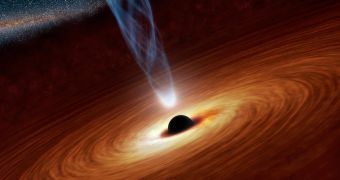There's much we don't know about black holes, but now there's one more thing we do know, how fast they spin. Technically, we know how fast one particular supermassive black hole (SMBH) spins; but now that we have this data, it can be used for all other similar objects.
NASA and ESA teamed up and used their X-ray telescopes, NASA's NuSTAR, designed to spot high-energy X-rays, and ESA's XMM-Newton which is tuned to lower energies, to look at the center of a giant galaxy nearby.
Using the two observatories, astronomers have been able to determine, for the first time, the spin rate of an SMBH. What they found is quite surprising.
This particular SMBH, at the center of the relatively close galaxy NGC 1365, 56 million light-years away, spins at very close to the speed of light, at the limit of what Einstein's theory of relativity allows.
There have been other attempts at measuring the spin of an SMBH, but this is the first time astronomers have conclusive results.
Not all SMBHs spin as fast as this one, their speed can vary greatly based on a number of factors. But the conditions were just right in this galaxy for its center SMBH, which weighs in at two million times the mass of the sun, to accelerate to huge speeds.
Astronomers long believed that they could observe the X-ray emissions from very near a black hole to make out how fast it spins, the faster it goes, the more "smudged" the X-ray light would be.
However, astronomers could not say conclusively that the light distortions they saw were due to the spin or the thick clouds of gas and dust that accompany black holes, which can also interfere with X-ray light.
Using the two observatories, astronomers were able to get precise measurements of the X-ray emitted by iron atoms very close to the point of no return. These showed that the distorted X-ray light could only have been created by the fast spinning black hole.
Small and heavy objects, which SMBHs definitely are, tend to move very fast. Neutron stars, which are extremely dense, can spin several times a second, even several hundred times a second.
The same is true for black holes, if they form from a collapsing star they will retain the star's spin. But as the material is pulled inward, the object spins up due to the conservation of angular momentum.
This means that a black hole will end up spinning quite fast, but not almost as fast as the speed of light. For it to accelerate further, certain things must happen.
Material falling into the black hole can accelerate it, but it can also slow it down. If it falls straight down, the black hole gets bigger so it slows down, again due to the conservation of angular momentum.
However, if the material falls down at an angle, it can gradually speed up the black hole. Another way for it to pick up speed is through the merger of two black holes or two supermassive black holes.
This will result in a much larger object that is spinning much faster, again, depending on the angle at which the two meet.
The NGC 1365 galaxy is one of the largest in the universe and it's very likely it formed by gobbling up other smaller galaxies.
These galaxies had black holes at their centers as well and some may have eventually merged with the SMBH in the center of NGC 1365, causing it to grow larger and spin faster.

 14 DAY TRIAL //
14 DAY TRIAL //